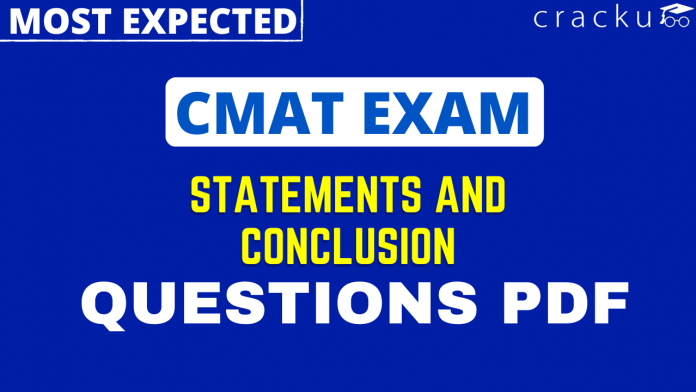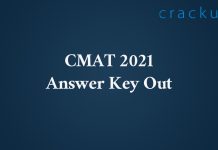CMAT Statements and Conclusion Questions [Download PDF]
Download Statements and Conclusion Questions for CMAT PDF – CMAT Statements and Conclusion Questions PDF by Cracku. Practice CMAT solved Statements and Conclusion Questions paper tests, and these are the practice question to have a firm grasp on the Statements and Conclusion topic in the XAT exam. Top 20 very Important Statements and Conclusion Questions for XAT based on asked questions in previous exam papers. Click on the link below to download the Statements and Conclusion Questions for CMAT PDF with detailed solutions.
Download Statements and Conclusion Questions for CMAT
Enroll to CMAT 2023 Crash Course
Question 1: Read the given statements carefully. Assuming that the information given in the statements is true, decide which of the given conclusions is correct based on the statements.
Statements:
1. Ram goes to mathematics class on Monday.
2. He attends literature classes on Friday.
3. He goes to guitar classes the day before he goes to history classes.
4. He attends history classes 2 days before literature classes.
a) Ram goes to guitar classes on Tuesday.
b) Ram goes to guitar classes on Sunday.
c) Ram goes to guitar classes on Saturday.
d) Ram attends history classes on Saturday.
1) Answer (A)
Solution:
Ram attends literature classes on Friday.
He attends history classes 2 days before literature classes.
$\Rightarrow$ Ram attends history classes on Wednesday.
He goes to guitar classes the day before he goes to history classes.
$\Rightarrow$ Ram goes to guitar classes on Tuesday.
Hence, the correct answer is Option A
Question 2: Read the given statement and conclusions carefully. Assuming that the information given in the statement is true, even if it appears to be at variance with commonly known facts, decide which of the given conclusions logically follow(s) from the statement.
Statement:
Most of the students usually fail to apply in practice what they studied on their courses in school and colleges because they studied the course just so they could pass the examination.
Conclusions:
I. Most of the students are just trying to pass the examination.
II. There is less emphasis on learning by teachers.
a) Both conclusions I and II follow.
b) Only conclusion II follows.
c) Only conclusion I follows.
d) Neither conclusion I nor II follows.
2) Answer (C)
Solution:
Given that Statement:
Most of the students usually fail to apply in practice what they studied on their courses in school and colleges because they studied the course just so they could pass the examination.
from the above statement, we check the Conclusions:
I. Most of the students are just trying to pass the examination. follows
II. There is less emphasis on learning by teachers. not follows
, therefore, the only conclusion I follow
Hence Option (C) Ans
Question 3: Read the given statement and conclusions carefully and decide which of the conclusions logically follow(s) from the statement.
Statement:
The importance of a person is not dependent only on one’s status and money.
Conclusions:
I.The goal of most people is just to acquire more money.
II.There are some factors other than status and money which contribute to the importance of a person.
a) Only conclusion I follows.
b) Both conclusions I and II follow.
c) Only conclusion II follows.
d) Neither conclusion I nor II follows.
3) Answer (C)
Solution:
Given that Statement:
The importance of a person is not dependent only on one’s status and money.
From the above statement, we check the Conclusions:
I.The goal of most people is just to acquire more money. not follow
II.There are some factors other than status and money which contribute to the importance of a person. Follows
, therefore, the Only Conclusion II follows
Hence Option (C) Ans
Question 4: The statements are given followed by two conclusions I and II. Consider the given statements as true and decide which of the given conclusions logically follow/s from the given statements.
Statements:
United Nation has adopted 21st June as world Yoga day. This has promoted India’s glorious tradition all over the world.
Conclusions:
I. Yoga is practiced only on 21st June.
II. More people are coming to India now to practice Yoga.
a) Neither conclusion I nor II follows.
b) Only conclusion I follows.
c) Only conclusion II follows.
d) Both conclusions I and II follow.
4) Answer (A)
Solution:
Given that Statements:
United Nation has adopted 21st June as world Yoga day. This has promoted India’s glorious tradition all over the world.
From the above we check the Conclusions:
I. Yoga is practiced only on 21st June. not Follow
II. More people are coming to India now to practice Yoga. not Follows
, therefore, Neither conclusion I nor conclusion II follows
Hence Option (A) Ans
Question 5: Read the given statement and conclusions carefully and decide which of the conclusions logically follow(s) from the statement.
Statement:
“On October 2, let us pledge to make the country free of single-use plastic.”- Prime Minister of India
Conclusions:
I. All Indians should reduce and then completely eliminate the consumption of single-use plastic like packaged drinking water
II. India is going to be completely plastic free on October 2
a) Only conclusion I follows
b) Both conclusions I and II follow
c) Only conclusion II follows
d) Neither conclusion I nor II follows
5) Answer (A)
Solution:
Given that Statement:
“On October 2, let us pledge to make the country free of single-use plastic.”- Prime Minister of India
From the above we check Conclusions:
I. All Indians should reduce and then completely eliminate the consumption of single-use plastic like packaged drinking water Follows
II. India is going to be completely plastic free on October 2 not follows
, therefore, the Only Conclusion I follows
Hence Option (A) Ans
Question 6: A statement is given followed by two conclusions I and II. Consider the given statement as true and decide which of the given conclusions logically follow/s from the given statement.
Statement:
The Prime Minister has made clear that his government will make concerted effort for the upliftment of poor farmers and announced an annual pension for them.
Conclusions:
I. Government understands that the condition of poor farmers needs immediate attention.
II. No benefits are announced for other sections of society.
a) Both conclusions I and II follows.
b) Only conclusion II follows.
c) Neither conclusion I nor II follows.
d) Only conclusion I follows.
6) Answer (D)
Solution:
Given that Statement:
The Prime Minister has made clear that his government will make concerted effort for the upliftment of poor farmers and announced an annual pension for them.
From the above statement we check Conclusions:
I. The government understands that the condition of poor farmers needs immediate attention. follows
II. No benefits are announced for other sections of society. not follow
therefore the only conclusion I follow
Hence Option (D) Ans
Question 7: In the question, two statements are given. You have to answer considering the statements to be true, even if they seem to be at variance from commonly known facts.
Statements I: Plants grow from seeds.
II: Seeds are produced by flowers.
Conclusion:
a) Flowers and seeds are produced by plants.
b) Plants grow from flowers.
c) Seeds are produced by plants.
d) Flowers are produced by plants.
7) Answer (B)
Solution:
Given, Plants grow from seeds and seeds are produced by flowers. So Plants grow from flowers.
Hence, the correct answer is Option B
Question 8: Read the given statements and conclusions carefully and decide which of the conclusion/s logically follow the statements.
Statement:
Physical abuse appears, so it is easy to accept, but mental abuse
Is not visible, so we keep denying it.
Conclusion:
1. It is easy to reject what we cannot see.
2. It is easy to accept what we see.
a) Only 1 can be concluded.
b) Both 1 and 2 can be concluded.
c) Only 2 can be concluded.
d) Only one of them can be concluded.
8) Answer (B)
Solution:
Conclusion :
1. It is easy to reject what we cannot see. : Follows
- We generally believe only what we see only.
2. It is easy to accept what we see. : Follows
- We accept what we see easily.
Both conclusion follows.
Hence, Option B is correct.
Question 9: Read the given statement and conclusions carefully and decide which of the conclusions logically follow(s) from the statement.
Statement:
Sama Veda is believed to be written around 200 BC.
Conclusions:
I. Sama Veda is one of the oldest books in history.
II. Sama Veda is the oldest book in history.
a) Neither conclusion I nor conclusion II follow.
b) Only Conclusion I follows.
c) Either conclusion I or conclusion II follows.
d) Only Conclusions II follows.
9) Answer (B)
Solution:
From the given statement, only the conclusion (I) can be concluded. Conclusion (II) cannot be concluded. Because we cannot say that ‘it is the only oldest book or not’ from the given information. But we can say that there are so many oldest books and out of which it is one of them.
Question 10: Read the given statement and conclusions carefully and decide which of the conclusions logically follow(s) from the statement.
Statement:
All philosophers are clever. Rakesh is a philosopher.
Conclusions:
I. Rakesh is not clever.
II. Rakesh is clever.
a) Both conclusions I and II follow
b) Only conclusion II follows.
c) Neither conclusion I nor II follows
d) Only conclusion I follows.
10) Answer (B)
Solution:
In the statement, it is given that ‘All philosophers are clever.’.

Rakesh is a philosopher. So he will also be clever.
Hence only conclusion II follows.
Question 11: Read the given statement and conclusions carefully and decide which of the conclusions logically follow(s) from the statement.
Statement:
A very large number of students love dancing in rain rather than studying in class.
Conclusion:
I: Rain keeps students healthy.
II: Dancing is a good Exercise.
a) Only conclusion I follows
b) Neither conclusion I nor II follows
c) Only conclusion II follows
d) Both conclusions I and II follow.
11) Answer (B)
Solution:
None of the given conclusions can be concluded from the given information. Because the first conclusion is saying about the relation of ‘students health’ and ‘Rain’ which is not given in the statement. Similarly, the second conclusion is saying about the ‘Dancing as an Exercise’. It is also not given in the statement.
Hence neither conclusion I nor II follows.
Question 12: Read the given statement and conclusions carefully and decide which of the conclusions logically follow(s) from the statement.
Statement:
Only white colour vehicles should be allowed in India for promoting peace.
Conclusions:
I. Blue colour vehicles promote peace.
II. White colour vehicles promote peace.
a) Only Conclusion I follows.
b) Only Conclusions II follows.
c) Neither conclusion I nor conclusion II follow
d) Either conclusion I or conclusion II follows.
12) Answer (B)
Solution:
As per the given statement, it can be concluded that ‘White colour vehicles promote peace.’. Because of the use of the word ‘only’, it is a well specific thing about a particular colour.
Hence option (b) is the correct answer.
Question 13: Read the given statement and conclusions carefully and decide which of the conclusions logically follow(s) from the statement.
Statement:
Sound cannot travel in vacuum.
Conclusions:
I. We cannot hear sound of explosion in vacuum.
II. We cannot hear sound of explosion in atmosphere.
a) Neither conclusion I nor conclusion II follow.
b) Either conclusion I or conclusion II follows.
c) Only Conclusion II follows.
d) Only Conclusion I follows.
13) Answer (D)
Solution:
As in the statement, it is given that ‘Sound cannot travel in vacuum.’. So we cannot hear the sound explosion in vacuum. Hence conclusion (I) follow.
Nothing is said in the statement about ‘atmosphere’. So we cannot say about it. Hence conclusion (II) does not follow.
Thus Only Conclusion I follows.
Question 14: Read the given statement and conclusions carefully and decide which of the conclusions logically follow(s) from the statement.
Statement:
Road offers the fastest connectivity between Agra and Delhi.
Conclusions:
I. There is no rail connectivity between Agra and Delhi.
II. There is no air connectivity between Agra and Delhi.
a) Neither conclusion I nor conclusion II follows.
b) Only conclusion II follows.
c) Only conclusion I follows.
d) Either conclusion I or conclusion II follows.
14) Answer (A)
Solution:
The given statement is saying about the connectivity between Agra and Delhi by road. But conclusions are saying about the connectivity of air and rail which is not given in the statement. Hence none of the given conclusions follows. Because we cannot say about them.
Question 15: In the following question below are given some statements followed by some conclusions based on those statements. Taking the given statements to be true even if they seem to be at variance from commonly known facts. Read all the conclusions and then decide which of the given conclusion logically follows the given statements.
Statements:
I. Some red are phone.
II. No phone is car.
Conclusions:
I. Some car are red.
II. Some phone are red.
a) Only conclusion II follows.
b) Only conclusion I follows.
c) Both conclusion I and II follows.
d) Neither conclusion follow.
15) Answer (A)
Solution:
Venn diagram for the given statement is as follows,

Conclusions:
I. Some car are red —> from the diagram, some car are not red, hence false.
II. Some phone are red —> Clearly, some phone are red, hence true.





